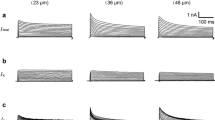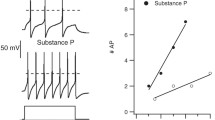Summary
Electrophysiological and pharmacological properties distinguished subtypes of adult mammalian dorsal root ganglion neurons (DRGn) in monolayer dissociated cell culture. By analogy of action potential waveform and duration, neurons with short duration (SDn) and long duration (LDn) action potentials resembled functionally distinct subtypes of DRGn in intact ganglia. Patch clamp and conventional intracellular recording techniques were combined here to elucidate differences in the ionic basis of excitability of subtypes of DRGn in vitro. Both SDn and LDn were quiescent at the resting potential. Action potentials of SDn were brief (< 2 msec), sensitive to tetrodotoxin (TTX, 5–10 nM), exhibited damped firing during long depolarizations, and did not respond to algesic agents applied by pressure ejection. Action potentials of LDn were 2–6 msec in duration, persisted in 30 µM TTX, and fired repetitively during depolarizing current pulses or exposure to algesic agents (e.g., capsaicin, histamine and bradykinin). Whole-cell recordings from freshly dissociated neurons revealed two inward sodium currents (INa; variable with changes in sodium but not calcium concentration in the superfusate) in various proportions: a rapidly activating and inactivating, TTX-sensitive current; and, a slower, TTX (30 μM)-resistant INa. Large neurons, presumable SDn, had predominantly TTX-sensitive current and little TTX-resistant current. The predominent inward current of small neurons, presumably LDn, was TTX-resistant with a smaller TTX-sensitive component. By analogy to findings from intact ganglia, these results suggest that fundamentally different ionic currents controlling excitability of subtypes of DRGn in vitro may contribute to functional differences between subtyes of neurons in situ.
Similar content being viewed by others
References
Erlanger J, Gasser HS: Electrical Signs of Nervous Activity, University of Pennsylvania Press, Philadelphia, 1938
Culp WJ, Ochoa J: Abnormal Nerves and Muscles as Impulse Generators, Oxford University Press, New York and Oxford, 1982
Harper AA, Lawson SN: Electrical properties of rat dorsal root ganglion neurones with different peripheral nerve conduction velocities. J Physiol 359:47–63, 1985
Harper AA, Lawson SN: Conduction velocity is related to morphologic cell type in rat dorsal root ganglion neurones. J Physiol 359:31–466, 1985
Rose RD, Koerber HR, Sedivec MJ, Mendell LM: Somal action potential duration differs in identified primary afferents. Neurosci Lett 63:259–264, 1986
Gallego R: The ionic basis of action potentials in petrosal ganglion cells of the cat. J Physiol 342:5991–6002, 1983
Yoshida S, Matsuda Y: Studies on sensory neurons of the mouse with intracellular-recording and horseradish peroxidase-injection techniques. J Neurophysiol 42(4):1134–1145, 1979
McLean MJ: Carbamazepine and phenytoin limit rapid firing of action potentials of dorsal root ganglion neurons in cell culture. Soc Neurosci Abs 12:1015, 1986
McLean MJ, Bennett PB: Subtypes of mammalian dosal root ganglion neurons in cell culture: electrophysiological studies using intracellular and patch clamp techniques. Soc Neurosci Abs 13:535, 1987
Rock DM, Taylor CP, McLean MJ: Effect of bradykinin and [des-arg9]-bradykinin on cultured human and mouse dorsal root ganglion neurons. Soc Neurosci Abs 13:780, 1987
McLean MJ, Bennett PB: Mixtures of tetrodotoxin-sensitive and resistant sodium currents in subtypes of adult mammalian dorsal root ganglion neurons in vitro. Submitted for publication
McLean MJ: Subtypes of adult mammalian dorsal root ganglion neurons in monolayer dissociated cell culture: electrophysiological and pharmaco-logical properties. In preparation 13. Bennett PB, McLean MJ: Tetrodotoxin-resistant Na channels in mouse, rat and human dorsal root ganglion neurons are functionally distinct from cardiac Na channels. Submitted for publication
Hamill OP, Marty A, Neher E, Sakmann B, Sigworth FJ: Improved patch-clamp techniques for high-resolution current recording from cells and cell-free membrane patches. Pflugers Arch. 391:85–100, 1981
Ransom BR, Neale E, Henkart M, Bullock PN, Nelson PG: Mouse spinal cord neurons in culture: I Morphology and intrinsic neuronal electrophysiological properties. J Neurophysiol 40:1132–1150, 1977
McLean MJ, Macdonald RL: Multiple actions of phenytoin on mouse spinal cord neurons in cell culture. J Pharmacol Exptl Ther 227(3):779–789, 1983
Bezanilla F: A high capacity data recording device based on a digitial audio processor and a video cassette recorder. Biophys J 47:437–441, 1985
Kostyuk PG, Krishtal OA, Pidoplichko VI: Effect of internal fluoride and phosphate on membrane currents during intracellular dialysis of nerve cells. Nature (Lond) 257:691–693, 1975
Horn R, Vandenberg CA: Statistical properties of single sodium channels. J Gen Physiol 84:505–534, 1984
Hess P, Tsien RW: Mechanism of ion permeation through calcium channels. Nature 3309:453–456, 1984
Almers W, McClesky EW. Non-selective conductance in calcium channels of frog muscle: calcium selectivity in a singlefile pore. J Physiol 353:585–608, 1984
Hille B. Ionic channels of excitable membranes. Sinauer Associates Inc Sunderland MA, 1984
Bossu JL, Feltz A: Patch-clamp study of the tetrodotoxin-resistant sodium current in group C sensory neurones. Neurosci Lett 51:241–246, 1984
Ikeda SR, Schofield GG, Weight FF: Na+ and Ca++ currents of acutely isolated adult rat nodose ganglion cells. J Neurophysiol 55:527–539, 1986
Ikeda SR, Schofield GG: Tetrodotoxin-resistant sodium current of rat nodose neurones: monovalent cation selectivity and divalent cation block. J Physiol (Lond) 389:255–270, 1987
Kostyuk PG, Veselovsky NS, Tsyndrenko AY: Ionic currents in the somatic membrane of rat dorsal root ganglion neurons. I Sodium currents Neurosci 6(12):2423–2430, 1981
Kameyama M: Ionic currents in cultured dorsal root ganglion cells from adult guinea pigs. J Membrane Biol 72:195–203, 1983
Sperelakis N, Shigenobu K, McLean MJ: Membrane cation channels — changes in developing hearts, in cell culture, and in organ culture. In: M Lieberman, T Sano (eds). Developmental and Physiological Correlates of Cardiac. Raven Press, New York, 1975
Levi R, DeFelice LJ: Sodium-conducting channels in cardiac membranes in low calcium. Biophys J 50:5–9, 1986
Ten Eick R, Yeh J, Matsuki N: Two types of voltage dependent Na channels suggested by differential sensitivity of single channels to tetrodotoxin. Biophys J 45:70–73, 1984
Harris JB, Thesleff S: Studies on the tetrodotoxin resistant action potentials in denervated skeletal muscle. Acta Physiol Scand 83:382–388, 1971
Pappone PA: Voltage-clamp experiments in normal and denervated mammalian skeletal muscle fibers. J Physiol (Lond) 306:377–410, 1980
Gonoi T, Sherman SJ, Catterall WA: Voltage clamp analysis of tetrodotoxin-sensitive and -insensitive sodium channels in rat muscle cells developing in vitro. J Neurosci 5:2559–2564, 1985
Weiss RE, Horn R: Functional differences between two classes of sodium channels in developing rat skeletal muscle. Science 233:361–364, 1986
Dichter MA, Fischbach GD: The action potential of chick dorsal root ganglion neurones maintained in cell culture. J Physiol 267:281–298, 1977
Heyer EJ, Macdonald RJ: Calcium- and sodium-dependent action potentials of mouse spinal cord and dorsal root ganglion neurons in cell culture. J Neurophysiol 47(4):641–655, 1982
Baccaglini PI, Cooper E: Electrophysiological studies of newborn rat nodose neurones in cell culture. J Physiol 324:429–439, 1982
Fukuda J, Kameyama M: Tetrodotoxin-sensitive and tetrodotoxin-resistant sodium channels in tissue-cultured spinal ganglion neurons from adult mammals. Brain Res 182:191–197, 1980
Scott BS, Edwards BAV: Electric membrane properties of adult mouse DRG neurons and the effect of culture duration. J Neurobiol 11(3):291–301, 1980
Baccaglini PI, Hogan PG: Some rat sensory neurons in culture express characteristics of differentiated pain sensory cells. Proc Natl Acad Sci 80:594–598, 1983
Swerdlow M: Anticonvulsant drugs and chronic pain. Clin Neuropharmacol 7:51–82, 1984
Asbury AK, Fields HL: Pain due to peripheral nerve damage: an hypothesis. Neurology 34:1587–1590, 1984
Strickland G, McLean MJ: Effects of anticonvulsant drugs, lidocaine and amitriptyline on repetitive firing of action potentials by adult mammalian neurons in monolayer dissociated cell culture. In preparation
Hondeghem LM, Katzung BG: Antiarrhythmic agents: the modulated receptor mechanism of action of sodium and calcium channel-blocking drugs. Ann Rev Pharmacol Toxicol 24:387–423, 1984
McLean MJ, Macdonald RL: Limitation of sustained high frequency repetitive firing: a common anticonvulsant drug mechanism of action. In: G Nistico et al. (eds), Neurotransmitters, Seizures and Epilepsy III. Raven Press, New York, 1986
Author information
Authors and Affiliations
Rights and permissions
About this article
Cite this article
McLean, M.J., Bennett, P.B. & Thomas, R.M. Subtypes of dorsal root ganglion neurons based on different inward currents as measured by whole-cell voltage clamp. Mol Cell Biochem 80, 95–107 (1989). https://doi.org/10.1007/BF00231008
Accepted:
Issue Date:
DOI: https://doi.org/10.1007/BF00231008




